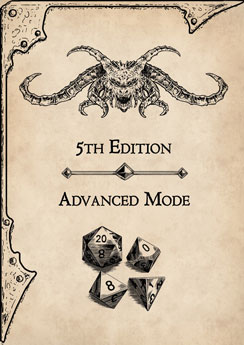Huge beast (giant animal), unaligned
Armor Class 12
Hit Points 157 (15d12 + 60)
Speed 40 ft., climb 40 ft.
Proficiency Bonus +3
Proficiency Bonus +6 (5th Edition Advanced Mode)
| STR | DEX | CON | INT | WIS | CHA |
|---|---|---|---|---|---|
| 23 (+6) | 14 (+2) | 18 (+4) | 7 (-2) | 12 (+1) | 7 (-2) |
Skills Athletics +9, Perception +4
Senses passive Perception 14
Languages –
Challenge 7 (2900 XP)
Crushing Grasp. If the giant ape score a successful hit with both fist he can crush the opponent for 28 (4d10+6) bludgeoning damage as a bonus action.
ACTIONS
- Multiattack. The ape makes two fist attacks.
- Fist. Melee Weapon Attack: +9 to hit, reach 10 ft., one target. Hit: 22 (3d10 + 6) bludgeoning damage.
- Rock. Ranged Weapon Attack: +9 to hit, range 50/100 ft., one target. Hit: 30 (7d6 + 6) bludgeoning damage.
5th Edition Advanced Mode
Limiting the power of a character and making the overall difficulty of the game harder, does not reduce the creativity, indeed it does quite the opposite.
The Game Master has the option to use any and all of the instances proposed in this guide, or just some of them according to their preference.
It is the lack of something that move and motivate characters, not the abundance of it
DESCRIPTION
The Giant Ape is a massive beast that resembles a gorilla, but with a more humanoid face and posture. It stands about 15 feet tall and weighs over 1,000 pounds. Its fur is usually black or brown, but some specimens have white or silver patches. Its eyes are intelligent and expressive, and its hands and feet are dexterous and powerful. The Giant Ape is a rare and elusive creature, often living in remote and mountainous regions. It is not a natural enemy of humans, but it will defend its territory and kin fiercely if threatened.
COMBAT
The Giant Ape is a formidable opponent in combat, using its strength and agility to pummel its foes with its fists or hurl rocks at them from a distance. It can also grapple and bite with its sharp teeth, or use its long arms to swing from trees or cliffs. The Giant Ape is not a mindless brute, however; it can use simple tactics and strategies, such as ambushing, flanking, or retreating when necessary. It can also communicate with other apes using vocalizations and gestures, coordinating their attacks or warning them of danger.
HABITAT / SOCIETY
The Giant Ape prefers to live in temperate or tropical forests, where it can find plenty of food and shelter. It is usually solitary or lives in small family groups of two to six individuals, consisting of a mated pair and their offspring. The Giant Ape is territorial and will mark its boundaries with urine, feces, or broken branches. It will tolerate other apes within its range, but will chase away any intruders that pose a threat. The Giant Ape is mostly herbivorous, feeding on fruits, nuts, leaves, roots, and occasionally insects or small animals. It will also scavenge carrion or hunt larger prey if food is scarce.
ECOLOGY
The Giant Ape plays an important role in the ecology of its habitat, as it disperses seeds through its feces and helps maintain the balance of the forest by pruning vegetation and controlling rodent populations. It also serves as a prey item for some predators, such as dragons, wyverns, or rocs.
